Economics Assignment: An Analysis of the Russian Economy Trends
VerifiedAdded on 2023/01/18
|15
|2819
|37
Homework Assignment
AI Summary
This economics assignment provides a detailed analysis of the Russian economy's performance between 2008 and 2018. It examines key economic indicators including real GDP, GDP growth rate, and per capita real GDP, revealing an overall increasing trend in real GDP, despite fluctuations. The analysis extends to the labor market, exploring unemployment trends and government measures to achieve full employment, highlighting a decline in unemployment rates. Furthermore, the assignment investigates inflation trends and the government's monetary policy strategies to maintain stable prices. The study considers the impact of the global financial crisis and the reliance on the energy sector. The assignment utilizes data from the World Bank to support its findings and discusses the transition of the Russian economy from a centrally planned to a market-oriented system, identifying both achievements and challenges.
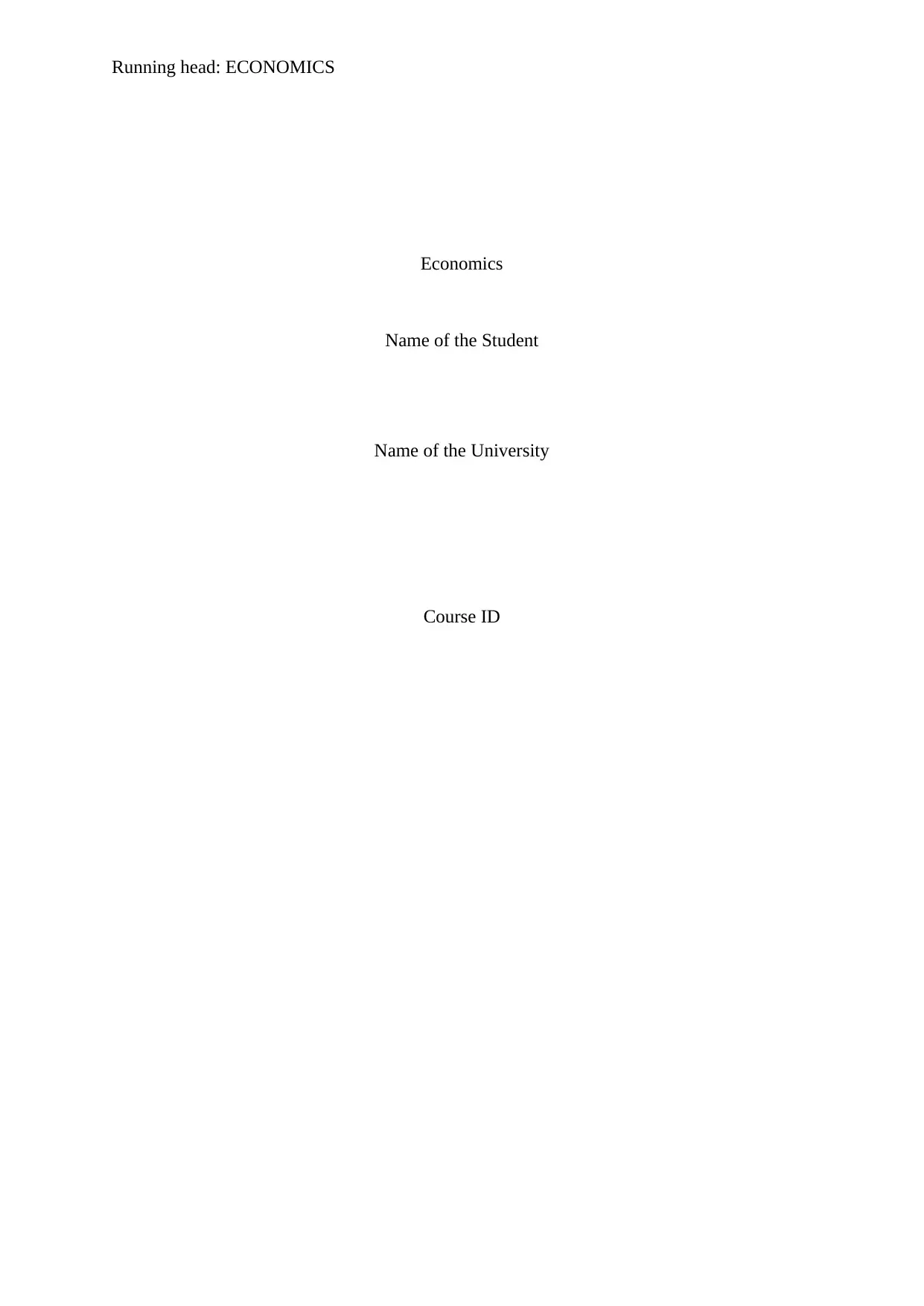
Running head: ECONOMICS
Economics
Name of the Student
Name of the University
Course ID
Economics
Name of the Student
Name of the University
Course ID
Paraphrase This Document
Need a fresh take? Get an instant paraphrase of this document with our AI Paraphraser
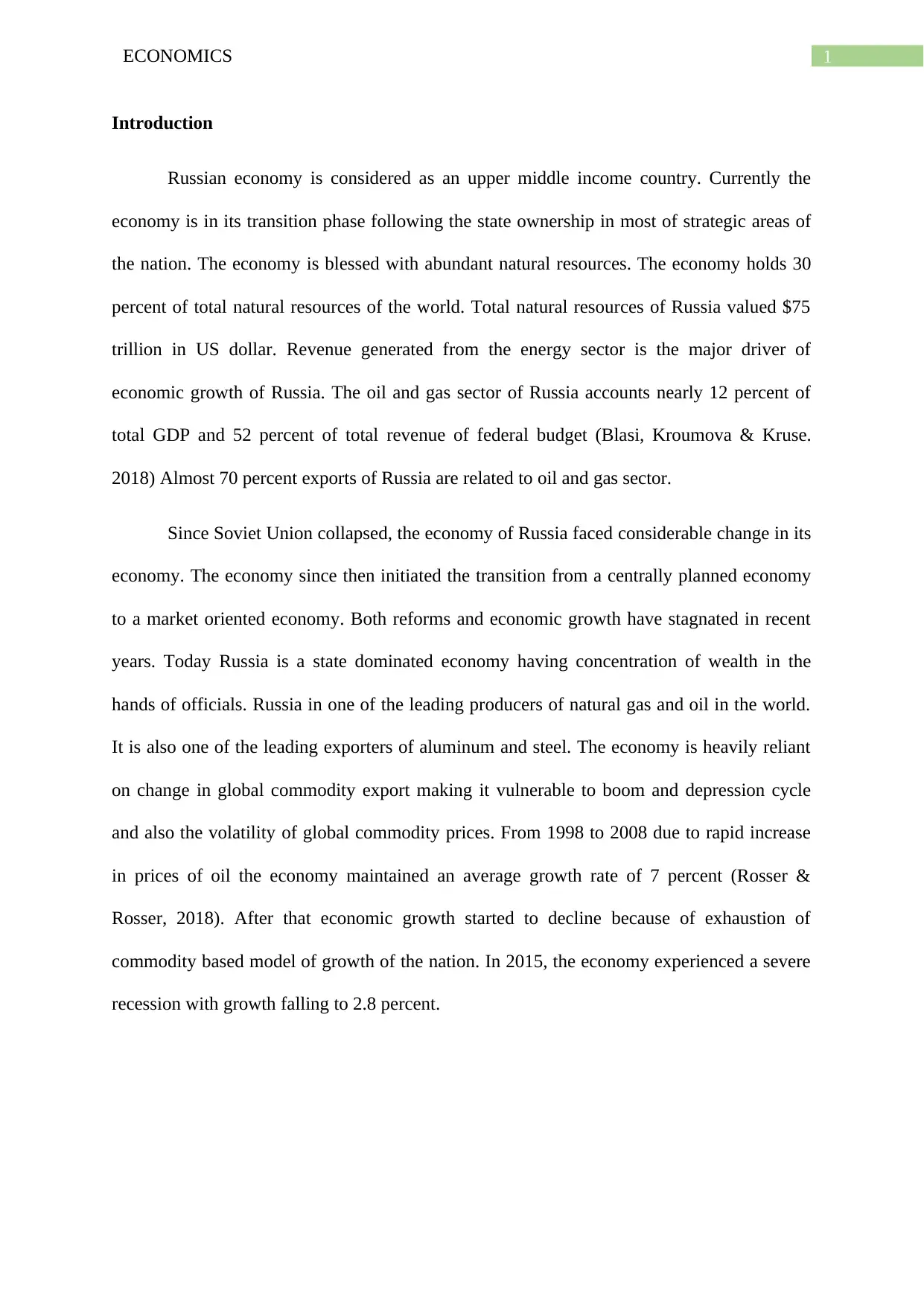
1ECONOMICS
Introduction
Russian economy is considered as an upper middle income country. Currently the
economy is in its transition phase following the state ownership in most of strategic areas of
the nation. The economy is blessed with abundant natural resources. The economy holds 30
percent of total natural resources of the world. Total natural resources of Russia valued $75
trillion in US dollar. Revenue generated from the energy sector is the major driver of
economic growth of Russia. The oil and gas sector of Russia accounts nearly 12 percent of
total GDP and 52 percent of total revenue of federal budget (Blasi, Kroumova & Kruse.
2018) Almost 70 percent exports of Russia are related to oil and gas sector.
Since Soviet Union collapsed, the economy of Russia faced considerable change in its
economy. The economy since then initiated the transition from a centrally planned economy
to a market oriented economy. Both reforms and economic growth have stagnated in recent
years. Today Russia is a state dominated economy having concentration of wealth in the
hands of officials. Russia in one of the leading producers of natural gas and oil in the world.
It is also one of the leading exporters of aluminum and steel. The economy is heavily reliant
on change in global commodity export making it vulnerable to boom and depression cycle
and also the volatility of global commodity prices. From 1998 to 2008 due to rapid increase
in prices of oil the economy maintained an average growth rate of 7 percent (Rosser &
Rosser, 2018). After that economic growth started to decline because of exhaustion of
commodity based model of growth of the nation. In 2015, the economy experienced a severe
recession with growth falling to 2.8 percent.
Introduction
Russian economy is considered as an upper middle income country. Currently the
economy is in its transition phase following the state ownership in most of strategic areas of
the nation. The economy is blessed with abundant natural resources. The economy holds 30
percent of total natural resources of the world. Total natural resources of Russia valued $75
trillion in US dollar. Revenue generated from the energy sector is the major driver of
economic growth of Russia. The oil and gas sector of Russia accounts nearly 12 percent of
total GDP and 52 percent of total revenue of federal budget (Blasi, Kroumova & Kruse.
2018) Almost 70 percent exports of Russia are related to oil and gas sector.
Since Soviet Union collapsed, the economy of Russia faced considerable change in its
economy. The economy since then initiated the transition from a centrally planned economy
to a market oriented economy. Both reforms and economic growth have stagnated in recent
years. Today Russia is a state dominated economy having concentration of wealth in the
hands of officials. Russia in one of the leading producers of natural gas and oil in the world.
It is also one of the leading exporters of aluminum and steel. The economy is heavily reliant
on change in global commodity export making it vulnerable to boom and depression cycle
and also the volatility of global commodity prices. From 1998 to 2008 due to rapid increase
in prices of oil the economy maintained an average growth rate of 7 percent (Rosser &
Rosser, 2018). After that economic growth started to decline because of exhaustion of
commodity based model of growth of the nation. In 2015, the economy experienced a severe
recession with growth falling to 2.8 percent.
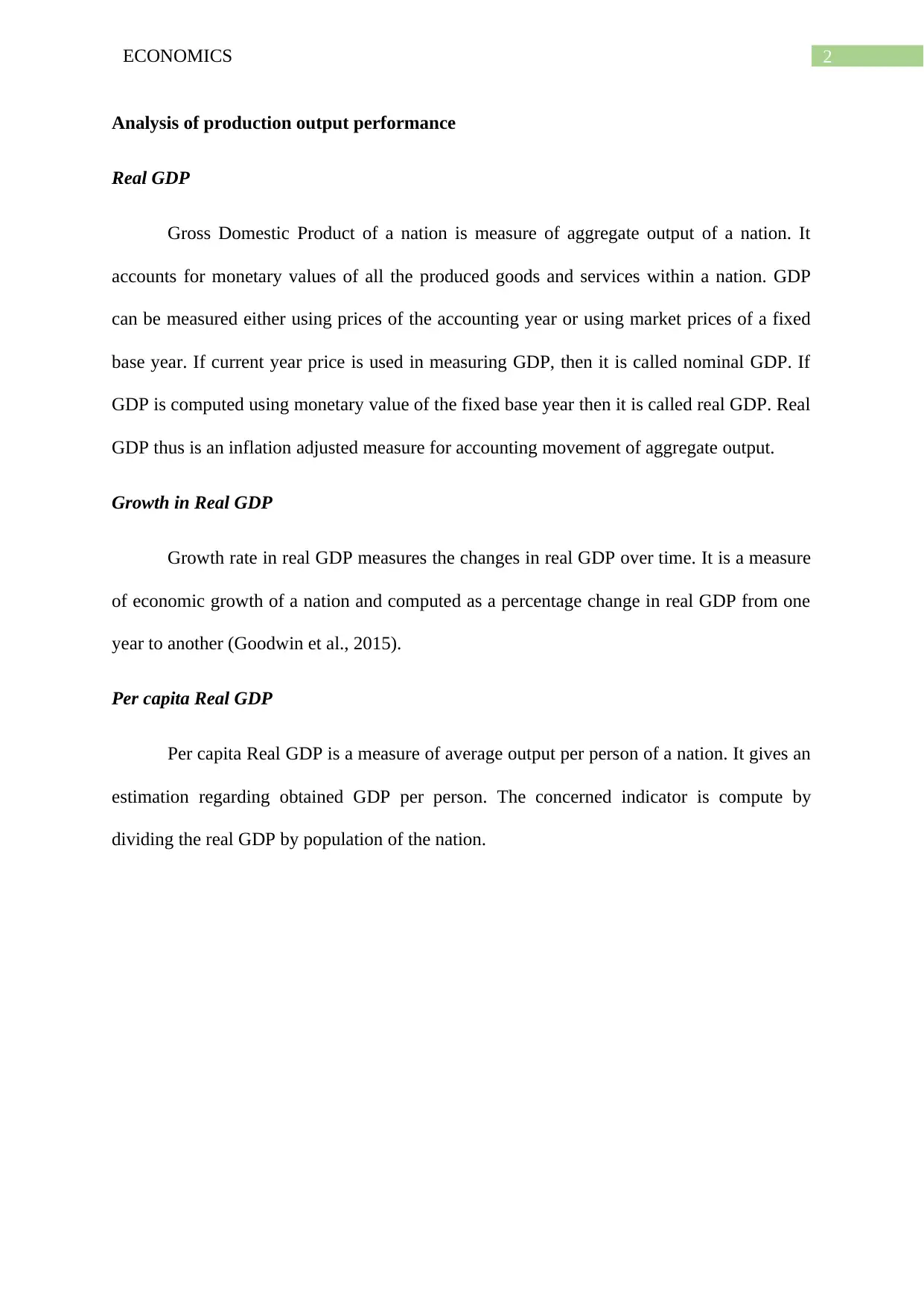
2ECONOMICS
Analysis of production output performance
Real GDP
Gross Domestic Product of a nation is measure of aggregate output of a nation. It
accounts for monetary values of all the produced goods and services within a nation. GDP
can be measured either using prices of the accounting year or using market prices of a fixed
base year. If current year price is used in measuring GDP, then it is called nominal GDP. If
GDP is computed using monetary value of the fixed base year then it is called real GDP. Real
GDP thus is an inflation adjusted measure for accounting movement of aggregate output.
Growth in Real GDP
Growth rate in real GDP measures the changes in real GDP over time. It is a measure
of economic growth of a nation and computed as a percentage change in real GDP from one
year to another (Goodwin et al., 2015).
Per capita Real GDP
Per capita Real GDP is a measure of average output per person of a nation. It gives an
estimation regarding obtained GDP per person. The concerned indicator is compute by
dividing the real GDP by population of the nation.
Analysis of production output performance
Real GDP
Gross Domestic Product of a nation is measure of aggregate output of a nation. It
accounts for monetary values of all the produced goods and services within a nation. GDP
can be measured either using prices of the accounting year or using market prices of a fixed
base year. If current year price is used in measuring GDP, then it is called nominal GDP. If
GDP is computed using monetary value of the fixed base year then it is called real GDP. Real
GDP thus is an inflation adjusted measure for accounting movement of aggregate output.
Growth in Real GDP
Growth rate in real GDP measures the changes in real GDP over time. It is a measure
of economic growth of a nation and computed as a percentage change in real GDP from one
year to another (Goodwin et al., 2015).
Per capita Real GDP
Per capita Real GDP is a measure of average output per person of a nation. It gives an
estimation regarding obtained GDP per person. The concerned indicator is compute by
dividing the real GDP by population of the nation.
⊘ This is a preview!⊘
Do you want full access?
Subscribe today to unlock all pages.

Trusted by 1+ million students worldwide
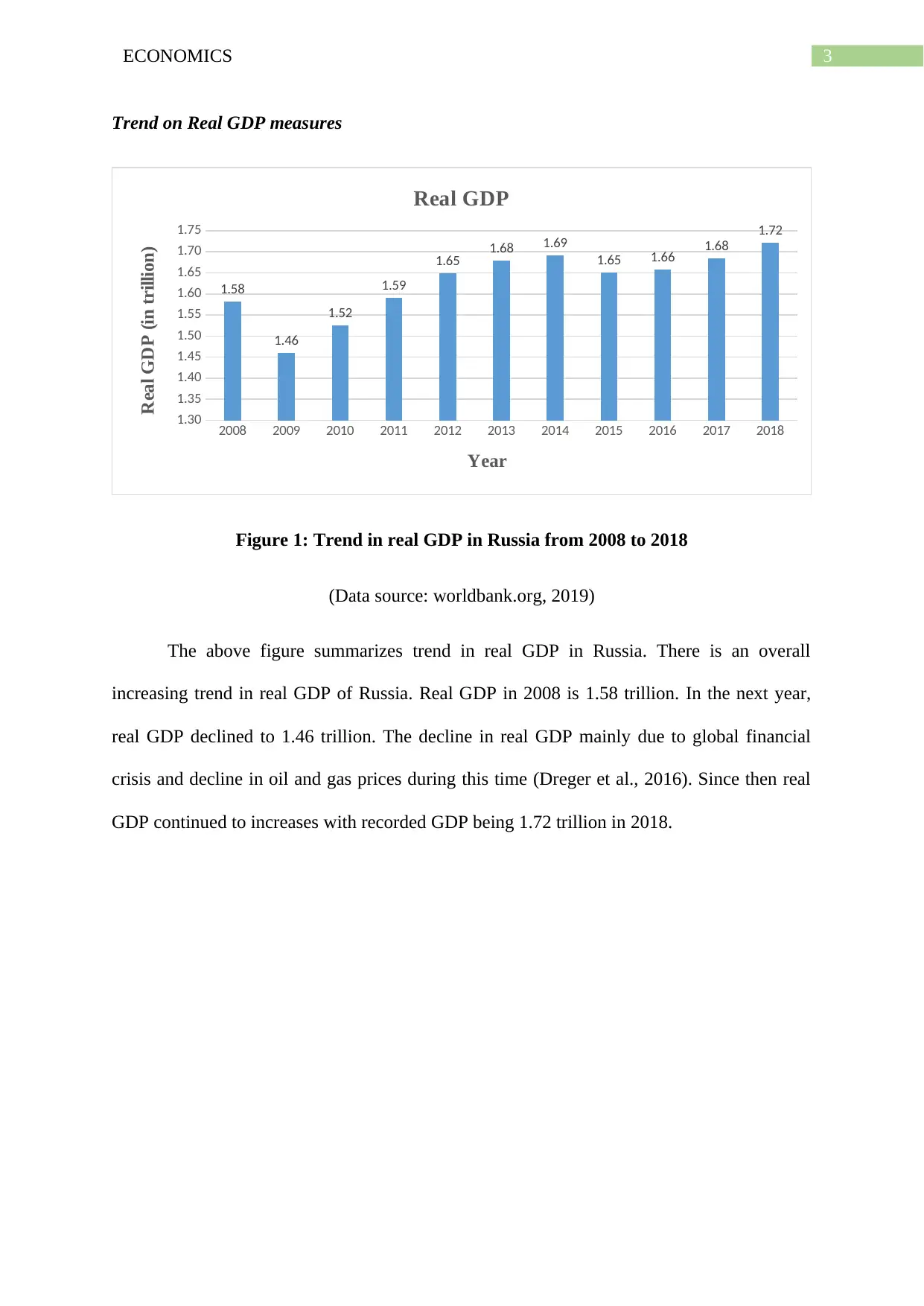
3ECONOMICS
Trend on Real GDP measures
2008 2009 2010 2011 2012 2013 2014 2015 2016 2017 2018
1.30
1.35
1.40
1.45
1.50
1.55
1.60
1.65
1.70
1.75
1.58
1.46
1.52
1.59
1.65 1.68 1.69
1.65 1.66 1.68
1.72
Real GDP
Year
Real GDP (in trillion)
Figure 1: Trend in real GDP in Russia from 2008 to 2018
(Data source: worldbank.org, 2019)
The above figure summarizes trend in real GDP in Russia. There is an overall
increasing trend in real GDP of Russia. Real GDP in 2008 is 1.58 trillion. In the next year,
real GDP declined to 1.46 trillion. The decline in real GDP mainly due to global financial
crisis and decline in oil and gas prices during this time (Dreger et al., 2016). Since then real
GDP continued to increases with recorded GDP being 1.72 trillion in 2018.
Trend on Real GDP measures
2008 2009 2010 2011 2012 2013 2014 2015 2016 2017 2018
1.30
1.35
1.40
1.45
1.50
1.55
1.60
1.65
1.70
1.75
1.58
1.46
1.52
1.59
1.65 1.68 1.69
1.65 1.66 1.68
1.72
Real GDP
Year
Real GDP (in trillion)
Figure 1: Trend in real GDP in Russia from 2008 to 2018
(Data source: worldbank.org, 2019)
The above figure summarizes trend in real GDP in Russia. There is an overall
increasing trend in real GDP of Russia. Real GDP in 2008 is 1.58 trillion. In the next year,
real GDP declined to 1.46 trillion. The decline in real GDP mainly due to global financial
crisis and decline in oil and gas prices during this time (Dreger et al., 2016). Since then real
GDP continued to increases with recorded GDP being 1.72 trillion in 2018.
Paraphrase This Document
Need a fresh take? Get an instant paraphrase of this document with our AI Paraphraser
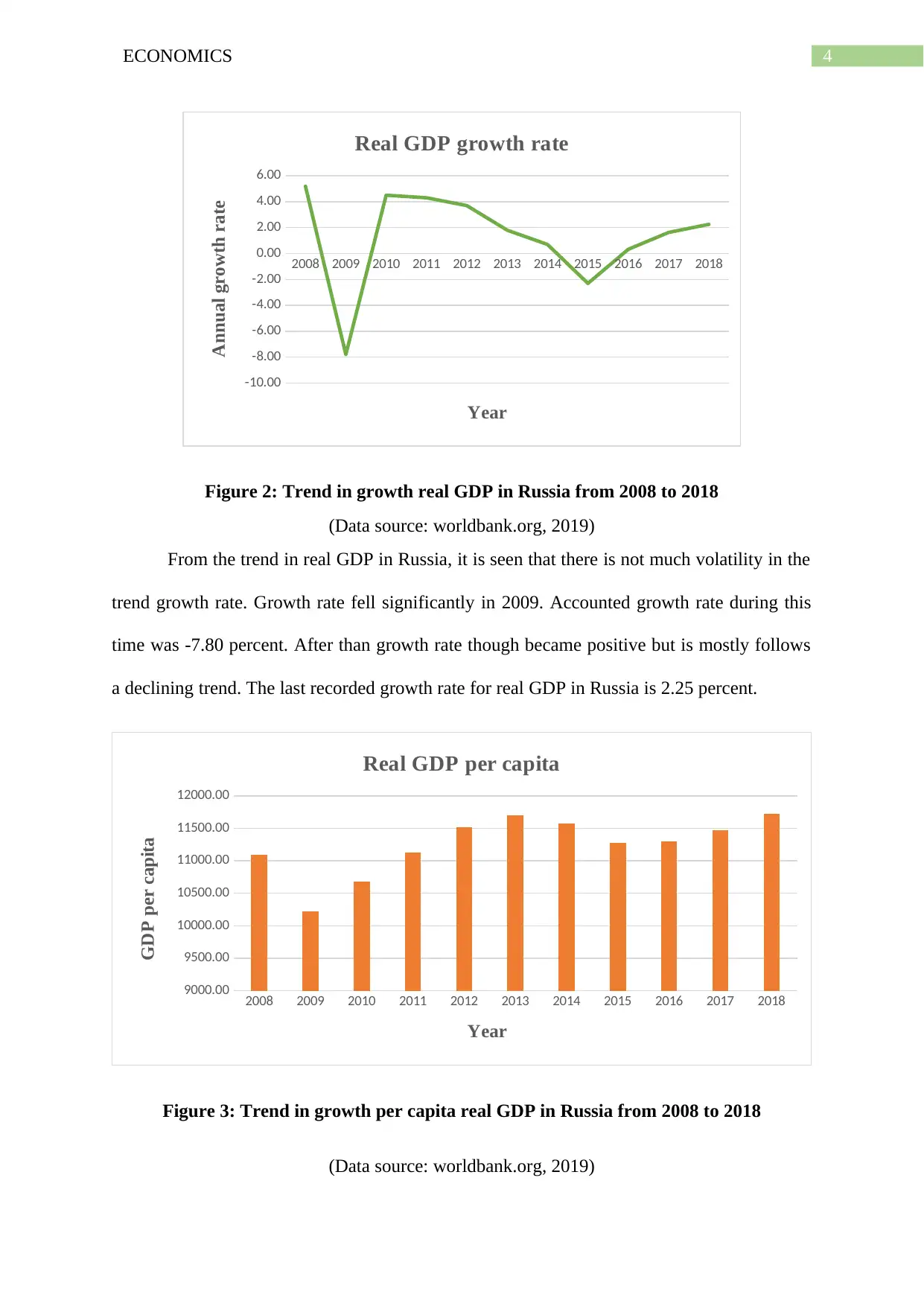
4ECONOMICS
2008 2009 2010 2011 2012 2013 2014 2015 2016 2017 2018
-10.00
-8.00
-6.00
-4.00
-2.00
0.00
2.00
4.00
6.00
Real GDP growth rate
Year
Annual growth rate
Figure 2: Trend in growth real GDP in Russia from 2008 to 2018
(Data source: worldbank.org, 2019)
From the trend in real GDP in Russia, it is seen that there is not much volatility in the
trend growth rate. Growth rate fell significantly in 2009. Accounted growth rate during this
time was -7.80 percent. After than growth rate though became positive but is mostly follows
a declining trend. The last recorded growth rate for real GDP in Russia is 2.25 percent.
2008 2009 2010 2011 2012 2013 2014 2015 2016 2017 2018
9000.00
9500.00
10000.00
10500.00
11000.00
11500.00
12000.00
Real GDP per capita
Year
GDP per capita
Figure 3: Trend in growth per capita real GDP in Russia from 2008 to 2018
(Data source: worldbank.org, 2019)
2008 2009 2010 2011 2012 2013 2014 2015 2016 2017 2018
-10.00
-8.00
-6.00
-4.00
-2.00
0.00
2.00
4.00
6.00
Real GDP growth rate
Year
Annual growth rate
Figure 2: Trend in growth real GDP in Russia from 2008 to 2018
(Data source: worldbank.org, 2019)
From the trend in real GDP in Russia, it is seen that there is not much volatility in the
trend growth rate. Growth rate fell significantly in 2009. Accounted growth rate during this
time was -7.80 percent. After than growth rate though became positive but is mostly follows
a declining trend. The last recorded growth rate for real GDP in Russia is 2.25 percent.
2008 2009 2010 2011 2012 2013 2014 2015 2016 2017 2018
9000.00
9500.00
10000.00
10500.00
11000.00
11500.00
12000.00
Real GDP per capita
Year
GDP per capita
Figure 3: Trend in growth per capita real GDP in Russia from 2008 to 2018
(Data source: worldbank.org, 2019)
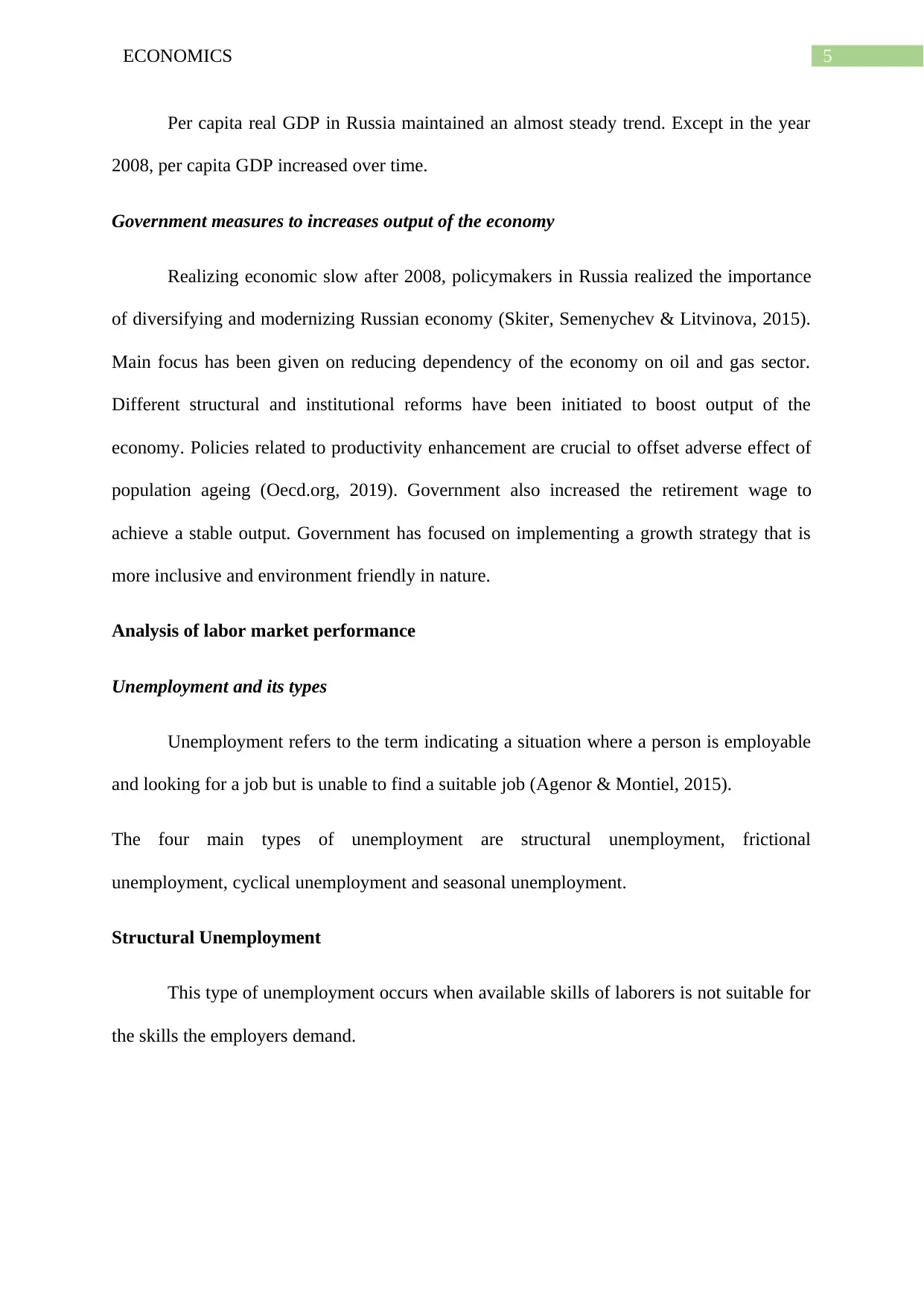
5ECONOMICS
Per capita real GDP in Russia maintained an almost steady trend. Except in the year
2008, per capita GDP increased over time.
Government measures to increases output of the economy
Realizing economic slow after 2008, policymakers in Russia realized the importance
of diversifying and modernizing Russian economy (Skiter, Semenychev & Litvinova, 2015).
Main focus has been given on reducing dependency of the economy on oil and gas sector.
Different structural and institutional reforms have been initiated to boost output of the
economy. Policies related to productivity enhancement are crucial to offset adverse effect of
population ageing (Oecd.org, 2019). Government also increased the retirement wage to
achieve a stable output. Government has focused on implementing a growth strategy that is
more inclusive and environment friendly in nature.
Analysis of labor market performance
Unemployment and its types
Unemployment refers to the term indicating a situation where a person is employable
and looking for a job but is unable to find a suitable job (Agenor & Montiel, 2015).
The four main types of unemployment are structural unemployment, frictional
unemployment, cyclical unemployment and seasonal unemployment.
Structural Unemployment
This type of unemployment occurs when available skills of laborers is not suitable for
the skills the employers demand.
Per capita real GDP in Russia maintained an almost steady trend. Except in the year
2008, per capita GDP increased over time.
Government measures to increases output of the economy
Realizing economic slow after 2008, policymakers in Russia realized the importance
of diversifying and modernizing Russian economy (Skiter, Semenychev & Litvinova, 2015).
Main focus has been given on reducing dependency of the economy on oil and gas sector.
Different structural and institutional reforms have been initiated to boost output of the
economy. Policies related to productivity enhancement are crucial to offset adverse effect of
population ageing (Oecd.org, 2019). Government also increased the retirement wage to
achieve a stable output. Government has focused on implementing a growth strategy that is
more inclusive and environment friendly in nature.
Analysis of labor market performance
Unemployment and its types
Unemployment refers to the term indicating a situation where a person is employable
and looking for a job but is unable to find a suitable job (Agenor & Montiel, 2015).
The four main types of unemployment are structural unemployment, frictional
unemployment, cyclical unemployment and seasonal unemployment.
Structural Unemployment
This type of unemployment occurs when available skills of laborers is not suitable for
the skills the employers demand.
⊘ This is a preview!⊘
Do you want full access?
Subscribe today to unlock all pages.

Trusted by 1+ million students worldwide
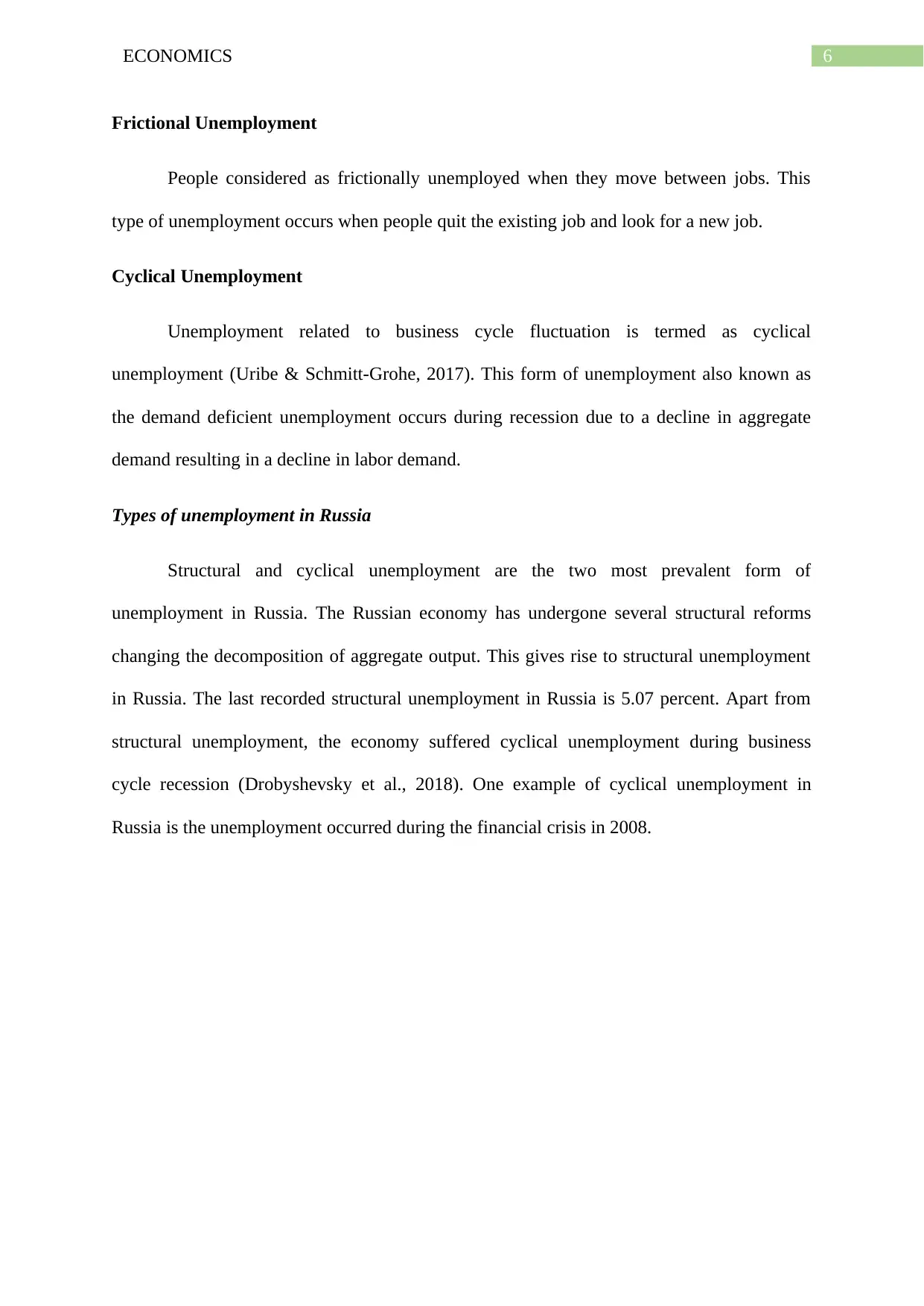
6ECONOMICS
Frictional Unemployment
People considered as frictionally unemployed when they move between jobs. This
type of unemployment occurs when people quit the existing job and look for a new job.
Cyclical Unemployment
Unemployment related to business cycle fluctuation is termed as cyclical
unemployment (Uribe & Schmitt-Grohe, 2017). This form of unemployment also known as
the demand deficient unemployment occurs during recession due to a decline in aggregate
demand resulting in a decline in labor demand.
Types of unemployment in Russia
Structural and cyclical unemployment are the two most prevalent form of
unemployment in Russia. The Russian economy has undergone several structural reforms
changing the decomposition of aggregate output. This gives rise to structural unemployment
in Russia. The last recorded structural unemployment in Russia is 5.07 percent. Apart from
structural unemployment, the economy suffered cyclical unemployment during business
cycle recession (Drobyshevsky et al., 2018). One example of cyclical unemployment in
Russia is the unemployment occurred during the financial crisis in 2008.
Frictional Unemployment
People considered as frictionally unemployed when they move between jobs. This
type of unemployment occurs when people quit the existing job and look for a new job.
Cyclical Unemployment
Unemployment related to business cycle fluctuation is termed as cyclical
unemployment (Uribe & Schmitt-Grohe, 2017). This form of unemployment also known as
the demand deficient unemployment occurs during recession due to a decline in aggregate
demand resulting in a decline in labor demand.
Types of unemployment in Russia
Structural and cyclical unemployment are the two most prevalent form of
unemployment in Russia. The Russian economy has undergone several structural reforms
changing the decomposition of aggregate output. This gives rise to structural unemployment
in Russia. The last recorded structural unemployment in Russia is 5.07 percent. Apart from
structural unemployment, the economy suffered cyclical unemployment during business
cycle recession (Drobyshevsky et al., 2018). One example of cyclical unemployment in
Russia is the unemployment occurred during the financial crisis in 2008.
Paraphrase This Document
Need a fresh take? Get an instant paraphrase of this document with our AI Paraphraser

7ECONOMICS
Trend in unemployment rate in Russia
2006 2008 2010 2012 2014 2016 2018 2020
4.00
4.50
5.00
5.50
6.00
6.50
7.00
7.50
8.00
8.50
9.00
Unemployment
Year
Rate of Unemployment
Figure 4: Trend in unemployment rate in Russia from 2008 to 2018
(Data source: worldbank.org, 2019)
The figure above summarizes overall unemployment trend in Russia from 2008 to
2018. Rate of unemployment in Russia increased significantly after the global financial crisis
in 2008. Rate of unemployment 2009 was recorded to be 8.30 percent in 2009 as compared to
6.20 percent in the previous year. After that unemployment rate continued to decline. Now
the economy reached to the lowest ever unemployment rate. The last accounted
unemployment rate in Russia is 4.80 percent. Factors contributing to steady decline in
unemployment rate include increase in real disposable income of household, a stable price
level and such others (tass.com, 2018).
Government measures to achieve full employment
Government of Russia has focused on achieving full employment by supporting the
labor market and has maintained its commitment towards minimizing the full employment.
The main employment strategy of Russia is based on the state program “Support to
Trend in unemployment rate in Russia
2006 2008 2010 2012 2014 2016 2018 2020
4.00
4.50
5.00
5.50
6.00
6.50
7.00
7.50
8.00
8.50
9.00
Unemployment
Year
Rate of Unemployment
Figure 4: Trend in unemployment rate in Russia from 2008 to 2018
(Data source: worldbank.org, 2019)
The figure above summarizes overall unemployment trend in Russia from 2008 to
2018. Rate of unemployment in Russia increased significantly after the global financial crisis
in 2008. Rate of unemployment 2009 was recorded to be 8.30 percent in 2009 as compared to
6.20 percent in the previous year. After that unemployment rate continued to decline. Now
the economy reached to the lowest ever unemployment rate. The last accounted
unemployment rate in Russia is 4.80 percent. Factors contributing to steady decline in
unemployment rate include increase in real disposable income of household, a stable price
level and such others (tass.com, 2018).
Government measures to achieve full employment
Government of Russia has focused on achieving full employment by supporting the
labor market and has maintained its commitment towards minimizing the full employment.
The main employment strategy of Russia is based on the state program “Support to
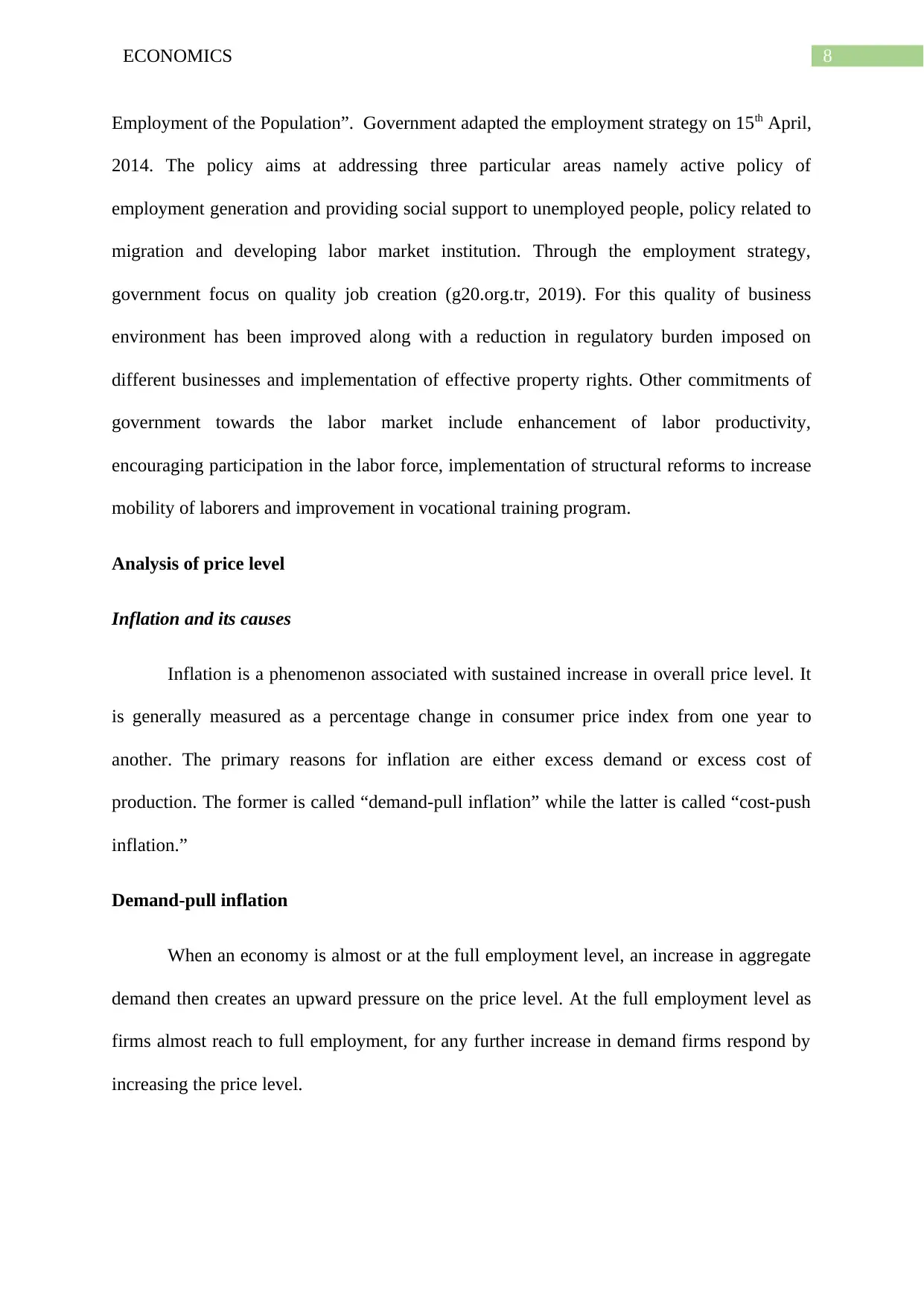
8ECONOMICS
Employment of the Population”. Government adapted the employment strategy on 15th April,
2014. The policy aims at addressing three particular areas namely active policy of
employment generation and providing social support to unemployed people, policy related to
migration and developing labor market institution. Through the employment strategy,
government focus on quality job creation (g20.org.tr, 2019). For this quality of business
environment has been improved along with a reduction in regulatory burden imposed on
different businesses and implementation of effective property rights. Other commitments of
government towards the labor market include enhancement of labor productivity,
encouraging participation in the labor force, implementation of structural reforms to increase
mobility of laborers and improvement in vocational training program.
Analysis of price level
Inflation and its causes
Inflation is a phenomenon associated with sustained increase in overall price level. It
is generally measured as a percentage change in consumer price index from one year to
another. The primary reasons for inflation are either excess demand or excess cost of
production. The former is called “demand-pull inflation” while the latter is called “cost-push
inflation.”
Demand-pull inflation
When an economy is almost or at the full employment level, an increase in aggregate
demand then creates an upward pressure on the price level. At the full employment level as
firms almost reach to full employment, for any further increase in demand firms respond by
increasing the price level.
Employment of the Population”. Government adapted the employment strategy on 15th April,
2014. The policy aims at addressing three particular areas namely active policy of
employment generation and providing social support to unemployed people, policy related to
migration and developing labor market institution. Through the employment strategy,
government focus on quality job creation (g20.org.tr, 2019). For this quality of business
environment has been improved along with a reduction in regulatory burden imposed on
different businesses and implementation of effective property rights. Other commitments of
government towards the labor market include enhancement of labor productivity,
encouraging participation in the labor force, implementation of structural reforms to increase
mobility of laborers and improvement in vocational training program.
Analysis of price level
Inflation and its causes
Inflation is a phenomenon associated with sustained increase in overall price level. It
is generally measured as a percentage change in consumer price index from one year to
another. The primary reasons for inflation are either excess demand or excess cost of
production. The former is called “demand-pull inflation” while the latter is called “cost-push
inflation.”
Demand-pull inflation
When an economy is almost or at the full employment level, an increase in aggregate
demand then creates an upward pressure on the price level. At the full employment level as
firms almost reach to full employment, for any further increase in demand firms respond by
increasing the price level.
⊘ This is a preview!⊘
Do you want full access?
Subscribe today to unlock all pages.

Trusted by 1+ million students worldwide
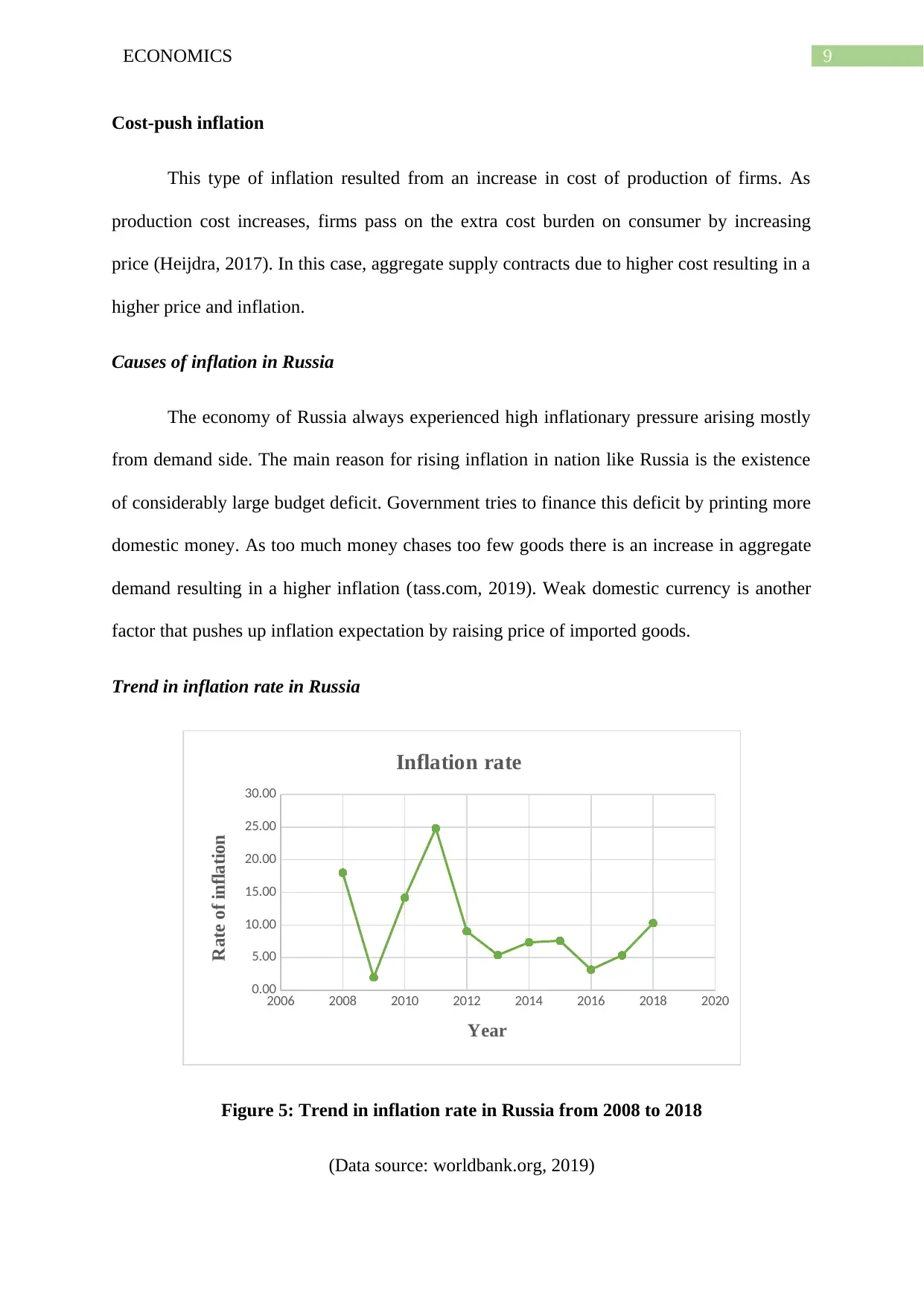
9ECONOMICS
Cost-push inflation
This type of inflation resulted from an increase in cost of production of firms. As
production cost increases, firms pass on the extra cost burden on consumer by increasing
price (Heijdra, 2017). In this case, aggregate supply contracts due to higher cost resulting in a
higher price and inflation.
Causes of inflation in Russia
The economy of Russia always experienced high inflationary pressure arising mostly
from demand side. The main reason for rising inflation in nation like Russia is the existence
of considerably large budget deficit. Government tries to finance this deficit by printing more
domestic money. As too much money chases too few goods there is an increase in aggregate
demand resulting in a higher inflation (tass.com, 2019). Weak domestic currency is another
factor that pushes up inflation expectation by raising price of imported goods.
Trend in inflation rate in Russia
2006 2008 2010 2012 2014 2016 2018 2020
0.00
5.00
10.00
15.00
20.00
25.00
30.00
Inflation rate
Year
Rate of inflation
Figure 5: Trend in inflation rate in Russia from 2008 to 2018
(Data source: worldbank.org, 2019)
Cost-push inflation
This type of inflation resulted from an increase in cost of production of firms. As
production cost increases, firms pass on the extra cost burden on consumer by increasing
price (Heijdra, 2017). In this case, aggregate supply contracts due to higher cost resulting in a
higher price and inflation.
Causes of inflation in Russia
The economy of Russia always experienced high inflationary pressure arising mostly
from demand side. The main reason for rising inflation in nation like Russia is the existence
of considerably large budget deficit. Government tries to finance this deficit by printing more
domestic money. As too much money chases too few goods there is an increase in aggregate
demand resulting in a higher inflation (tass.com, 2019). Weak domestic currency is another
factor that pushes up inflation expectation by raising price of imported goods.
Trend in inflation rate in Russia
2006 2008 2010 2012 2014 2016 2018 2020
0.00
5.00
10.00
15.00
20.00
25.00
30.00
Inflation rate
Year
Rate of inflation
Figure 5: Trend in inflation rate in Russia from 2008 to 2018
(Data source: worldbank.org, 2019)
Paraphrase This Document
Need a fresh take? Get an instant paraphrase of this document with our AI Paraphraser
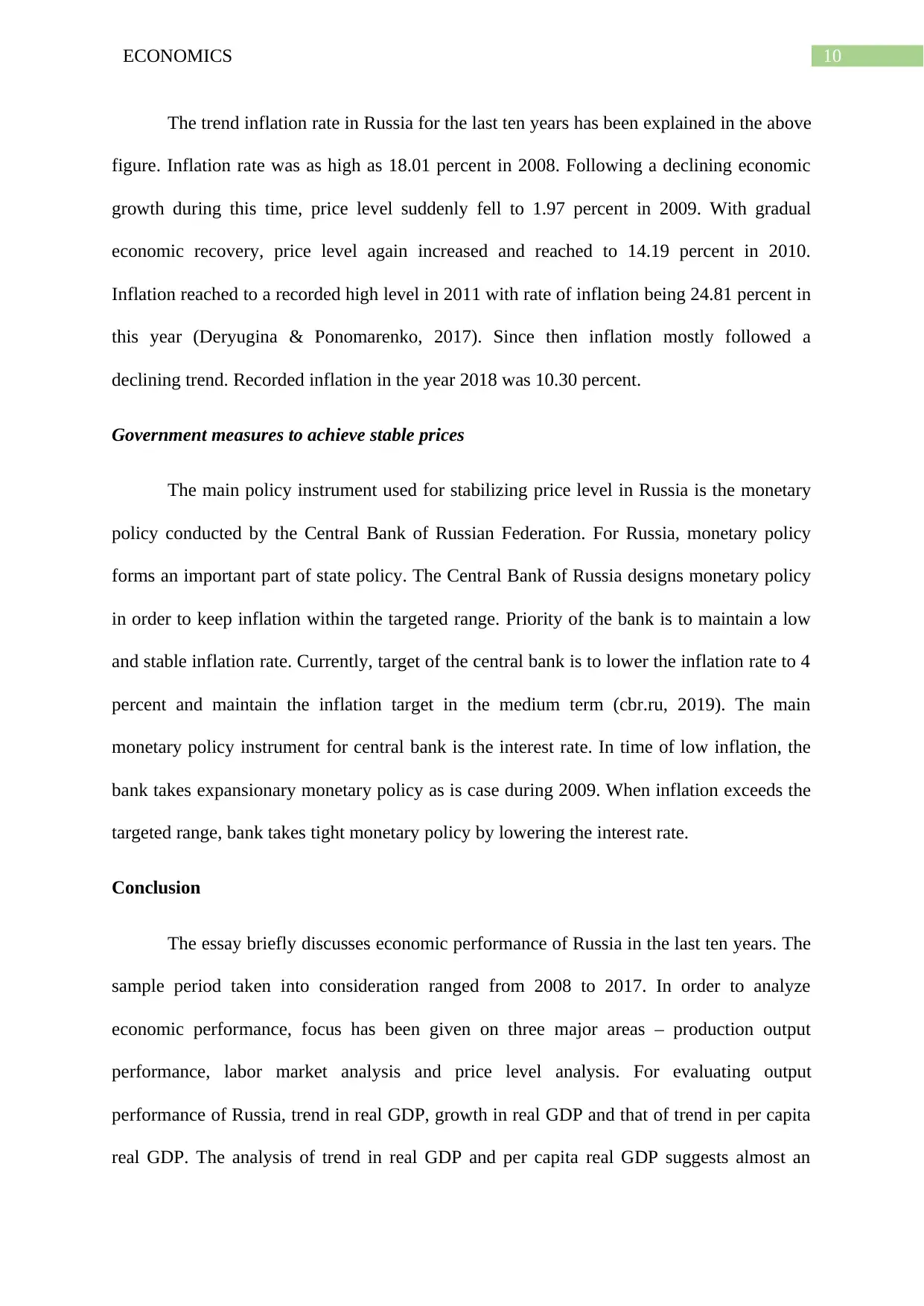
10ECONOMICS
The trend inflation rate in Russia for the last ten years has been explained in the above
figure. Inflation rate was as high as 18.01 percent in 2008. Following a declining economic
growth during this time, price level suddenly fell to 1.97 percent in 2009. With gradual
economic recovery, price level again increased and reached to 14.19 percent in 2010.
Inflation reached to a recorded high level in 2011 with rate of inflation being 24.81 percent in
this year (Deryugina & Ponomarenko, 2017). Since then inflation mostly followed a
declining trend. Recorded inflation in the year 2018 was 10.30 percent.
Government measures to achieve stable prices
The main policy instrument used for stabilizing price level in Russia is the monetary
policy conducted by the Central Bank of Russian Federation. For Russia, monetary policy
forms an important part of state policy. The Central Bank of Russia designs monetary policy
in order to keep inflation within the targeted range. Priority of the bank is to maintain a low
and stable inflation rate. Currently, target of the central bank is to lower the inflation rate to 4
percent and maintain the inflation target in the medium term (cbr.ru, 2019). The main
monetary policy instrument for central bank is the interest rate. In time of low inflation, the
bank takes expansionary monetary policy as is case during 2009. When inflation exceeds the
targeted range, bank takes tight monetary policy by lowering the interest rate.
Conclusion
The essay briefly discusses economic performance of Russia in the last ten years. The
sample period taken into consideration ranged from 2008 to 2017. In order to analyze
economic performance, focus has been given on three major areas – production output
performance, labor market analysis and price level analysis. For evaluating output
performance of Russia, trend in real GDP, growth in real GDP and that of trend in per capita
real GDP. The analysis of trend in real GDP and per capita real GDP suggests almost an
The trend inflation rate in Russia for the last ten years has been explained in the above
figure. Inflation rate was as high as 18.01 percent in 2008. Following a declining economic
growth during this time, price level suddenly fell to 1.97 percent in 2009. With gradual
economic recovery, price level again increased and reached to 14.19 percent in 2010.
Inflation reached to a recorded high level in 2011 with rate of inflation being 24.81 percent in
this year (Deryugina & Ponomarenko, 2017). Since then inflation mostly followed a
declining trend. Recorded inflation in the year 2018 was 10.30 percent.
Government measures to achieve stable prices
The main policy instrument used for stabilizing price level in Russia is the monetary
policy conducted by the Central Bank of Russian Federation. For Russia, monetary policy
forms an important part of state policy. The Central Bank of Russia designs monetary policy
in order to keep inflation within the targeted range. Priority of the bank is to maintain a low
and stable inflation rate. Currently, target of the central bank is to lower the inflation rate to 4
percent and maintain the inflation target in the medium term (cbr.ru, 2019). The main
monetary policy instrument for central bank is the interest rate. In time of low inflation, the
bank takes expansionary monetary policy as is case during 2009. When inflation exceeds the
targeted range, bank takes tight monetary policy by lowering the interest rate.
Conclusion
The essay briefly discusses economic performance of Russia in the last ten years. The
sample period taken into consideration ranged from 2008 to 2017. In order to analyze
economic performance, focus has been given on three major areas – production output
performance, labor market analysis and price level analysis. For evaluating output
performance of Russia, trend in real GDP, growth in real GDP and that of trend in per capita
real GDP. The analysis of trend in real GDP and per capita real GDP suggests almost an
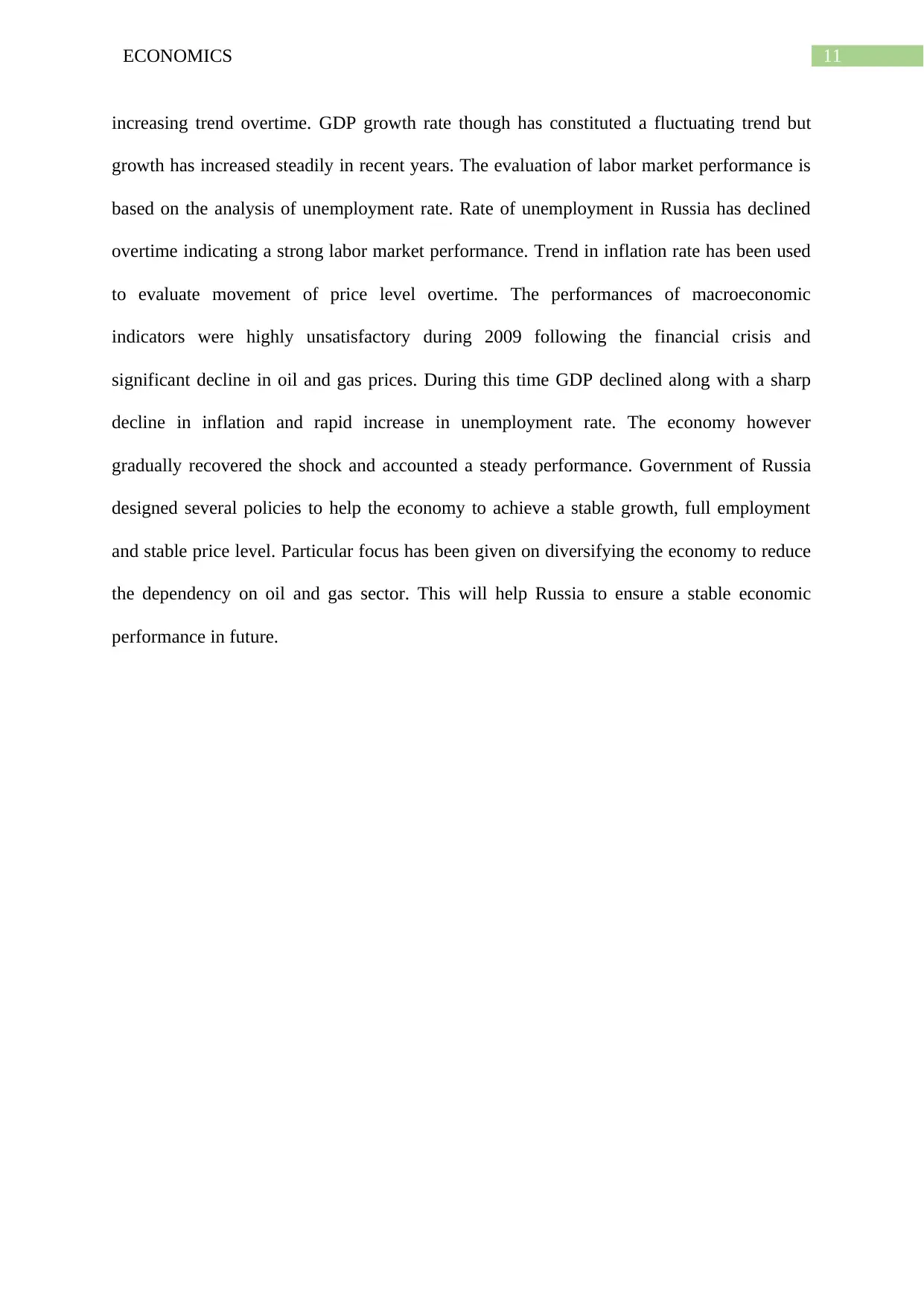
11ECONOMICS
increasing trend overtime. GDP growth rate though has constituted a fluctuating trend but
growth has increased steadily in recent years. The evaluation of labor market performance is
based on the analysis of unemployment rate. Rate of unemployment in Russia has declined
overtime indicating a strong labor market performance. Trend in inflation rate has been used
to evaluate movement of price level overtime. The performances of macroeconomic
indicators were highly unsatisfactory during 2009 following the financial crisis and
significant decline in oil and gas prices. During this time GDP declined along with a sharp
decline in inflation and rapid increase in unemployment rate. The economy however
gradually recovered the shock and accounted a steady performance. Government of Russia
designed several policies to help the economy to achieve a stable growth, full employment
and stable price level. Particular focus has been given on diversifying the economy to reduce
the dependency on oil and gas sector. This will help Russia to ensure a stable economic
performance in future.
increasing trend overtime. GDP growth rate though has constituted a fluctuating trend but
growth has increased steadily in recent years. The evaluation of labor market performance is
based on the analysis of unemployment rate. Rate of unemployment in Russia has declined
overtime indicating a strong labor market performance. Trend in inflation rate has been used
to evaluate movement of price level overtime. The performances of macroeconomic
indicators were highly unsatisfactory during 2009 following the financial crisis and
significant decline in oil and gas prices. During this time GDP declined along with a sharp
decline in inflation and rapid increase in unemployment rate. The economy however
gradually recovered the shock and accounted a steady performance. Government of Russia
designed several policies to help the economy to achieve a stable growth, full employment
and stable price level. Particular focus has been given on diversifying the economy to reduce
the dependency on oil and gas sector. This will help Russia to ensure a stable economic
performance in future.
⊘ This is a preview!⊘
Do you want full access?
Subscribe today to unlock all pages.

Trusted by 1+ million students worldwide
1 out of 15